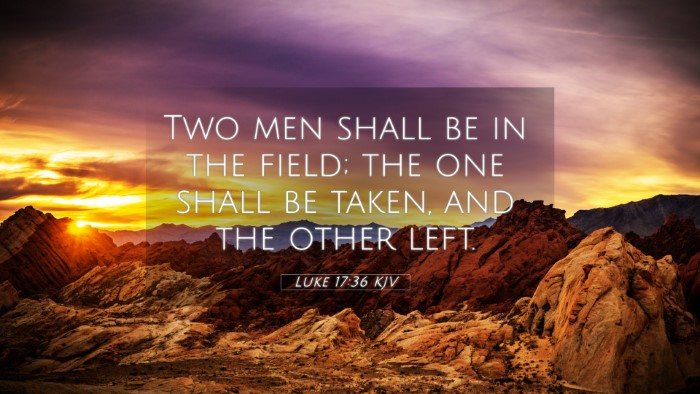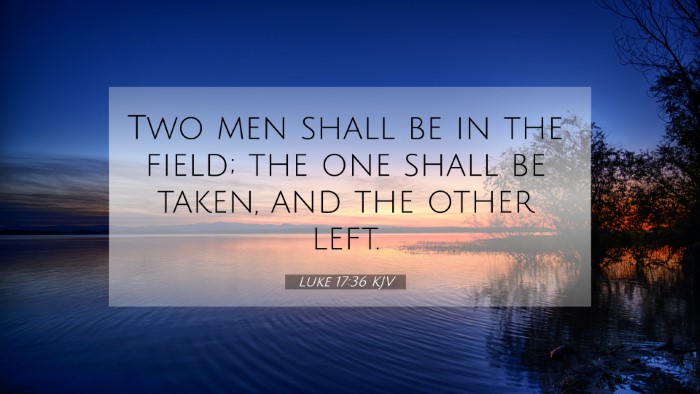Understanding Luke 17:36
Verse: Luke 17:36 states, "Two men shall be in the field; the one shall be taken, and the other left."
Summary of Meaning
The verse emphasizes themes of separation and judgment, portraying a scenario where two individuals are engaged in daily work, yet their destinies diverge. This imagery reflects the imminent return of Christ and the sudden distinction between the righteous and the unrighteous.
Commentary Insights
Matthew Henry's Commentary
Matthew Henry highlights that this verse underscores the unpredictability of the Lord’s return. The workmen represent people in their everyday lives. Henry points out that this division signifies God's judgment, where one will be saved and the other left behind, sparking contemplation about readiness for Christ's return.
Albert Barnes' Notes
Albert Barnes elaborates on the idea that this parable serves as a warning. He notes that it illustrates the final separation of believers and non-believers and encourages vigilance among listeners. The reference to "two men" emphasizes that even among close acquaintances, the outcome may dramatically differ based on one's spiritual state.
Adam Clarke's Commentary
Adam Clarke reflects on the socio-religious implications of the verse. He explains that being "taken" symbolizes being chosen or saved, while being "left" indicates judgment. Clarke emphasizes that this separation will occur at an unexpected time, urging readers to remain spiritually alert and prepared for the return of the Lord.
Connections with Other Bible Verses
Luke 17:36 can be understood better through cross-references with other significant scriptures. Here are some related Bible verses:
- Matthew 24:40-41: Similar to Luke's warning, it conveys the suddenness of God's judgment during the end times.
- 1 Thessalonians 4:17: This passage depicts the rapture, where believers are taken to meet the Lord, resonating with the idea of being "taken" in Luke 17:36.
- Matthew 25:31-33: The parable of the sheep and goats further emphasizes the separation based on individual choices and faithfulness.
- Genesis 7:23: During the Flood, the saved and unsaved were divided, illustrating God's judgment and mercy.
- 2 Peter 3:10: This verse speaks about the day of the Lord coming unexpectedly, urging believers to be prepared.
- Revelation 3:3: This verse warns to be watchful, reinforcing the need for spiritual readiness.
- John 10:16: It touches on the theme of having a shepherd who separates His people, linking back to the separation depicted in Luke 17:36.
Thematic Bible Verse Connections
The themes of judgment, preparedness, and the division of the faithful from the unfaithful are prevalent throughout the Bible. Understanding these connections enhances the interpretation of Luke 17:36:
- Preparedness: Believers are called to be vigilant and ready for an unannounced return of Christ (Mark 13:33).
- Spiritual Division: The distinction between those committed to God and those who aren't is exemplified in the story of the rich man and Lazarus (Luke 16:19-31).
- The Call to Watchfulness: Multiple scriptures encourage watchfulness (1 Peter 5:8), enforcing that readiness is key.
Conclusion
Luke 17:36 serves as a striking reminder of the reality of spiritual separation at Christ's return. It invites reflection on one's own relationship with God and encourages believers to seek readiness through faith and vigilance. By cross-referencing related biblical texts, we can gain a deeper understanding of the weighty themes of judgment, salvation, and the unexpected nature of God's timing.
Further Study and Tools
For those interested in exploring further, using tools for Bible cross-referencing can deepen understanding. A Bible concordance or a cross-reference guide assists in navigating the interconnections between verses, enhancing both personal study and sermon preparation.


